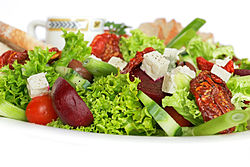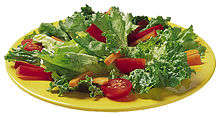Salad: Difference between revisions
Slowking Man (talk | contribs) m Reverted edits by Joseypeter (talk) to last version by Antandrus |
|||
| Line 107: | Line 107: | ||
* [[Watergate salad]] |
* [[Watergate salad]] |
||
'''Bold text'''omfg danielle rocks the fuckin world |
|||
==History== |
|||
During the [[Middle Ages]], after eating mostly salted meats and pickled vegetables all winter, people would be "salt-sick" and looked forward to spring greens. Popular history asserts that peasants ate more salads than lords, and were the healthier for it; in fact salads, cooked and raw, included many ingredients that would be "gourmet" today: [[lovage]], [[Sanguisorba|burnet]], [[sorrel]]. |
|||
The [[diary|diarist]] [[John Evelyn]] wrote a book on salads, ''[[Acetaria: A Discourse on Sallets]]'' (1699), that describes the new salad greens like "sellery" (celery), coming out of [[Italy]] and the [[Netherlands]]. |
|||
==External links== |
==External links== |
||
Revision as of 00:21, 9 December 2006

Salad is a term applied broadly to many food preparations that are a mixture of chopped or sliced ingredients. A salad can be served cold or at room temperature, and it can also form the filling for a sandwich. Though it can be made with meat or eggs, it usually includes at least one raw vegetable or fruit, most often lettuce. Often it is prepared or served with a dressing.
A salad may be served before or after the main dish as a separate course, as a main course in itself, or as a side dish.
Salad may refer to a blended food item— often meat, seafood or eggs blended with mayonnaise, finely chopped vegetables and seasonings— which can be served as part of a green salad or used as a sandwich filling. Salads of this kind include egg, chicken, tuna, shrimp, and ham salad.
In Scandinavia, salad also refers to a blend of vegetables in a dressing used as a condiment on top of the open sandwich, smørrebrød, and with meats. Examples include cucumber salad, horseradish salad, Italian salad (a mixture of vegetables in a crème fraîche/mayonnaise dressing, served on ham), and Russian salad (a red beet salad).
The word "salad" comes from the French salade of the same meaning, from the Latin salata, "salty", from sal, "salt". (See also sauce, salsa, sausage.)


The green salad

The "green salad" is most often composed of a mixture of uncooked or cold cooked vegetables, built up on a base of leaf vegetables such as one or more lettuce varieties, spinach, or arugula.
Other common vegetables in a green salad include tomato, cucumber, peppers, mushroom, onion, spring onion, red onion, carrot and radish. Other ingredients such as pasta, olives, cooked potatoes, rice, beans, croutons, meat (e.g. bacon, chicken), cheese, or fish (e.g. tuna) are sometimes added to salads.
Types of green salad

- Caesar salad
- Chef salad
- Chopped salad
- Cobb salad
- Greek salad
- Chilean salad
- Hawaiian salad
- Italian salad
- French Salad
- Spring Salad
- Mesclun salad
- Provençale salad
- Niçoise salad
- Chèvre chaud salad
- Gésier salad
- Mâche salad
- Cucumber salad
- Antillaise salad
- Watercress salad
- Tossed salad
- Pittsburgh Salad
Dressings
A green salad is often served with a dressing. Some examples include:
The concept of salad dressing varies across cultures. There are many commonly used salad dressings in North America. Traditional dressings in southern Europe are vinaigrettes, while mayonnaise is predominant in eastern European countries and Russia. In Denmark dressings are often based on crème fraîche. In China, where Western salad is a recent adoption from Western cuisine, the term salad dressing (沙拉酱, shalajiang) tends to refer to mayonnaise or mayonnaise-based dressings.
Garnishes
There are various vegetables and other fare that are often added to green salad. Some of them are:
- shelled sunflower seeds
- onions (mostly the red variety)
- bacon bits (sometimes the bits are artificially flavored pieces of textured soybean protein)
- radishes
- grated carrots
- tomatoes
- surimi - artificial crab meat
- cucumbers
- bell peppers
Again, individual taste usually governs the choice of salad garnishes.
Other types of salad
 |
 |
Some salads are based on food items other than fresh vegetables:
- Antipasto salad
- Bean salad
- Chicken salad
- Coleslaw
- Congealed salad
- Egg salad
- Fruit salad
- Israeli salad
- Larb from Laos
- Pasta salad
- Potato salad
- Russian salad
- Shopska salad from Bulgaria
- Somen salad from Japan
- Som tam (Thai ส้มตำ) or Green Papaya Salad from Thailand
- Tabouli
- Tuna salad
- Waldorf salad
- Watergate salad
Bold textomfg danielle rocks the fuckin world
